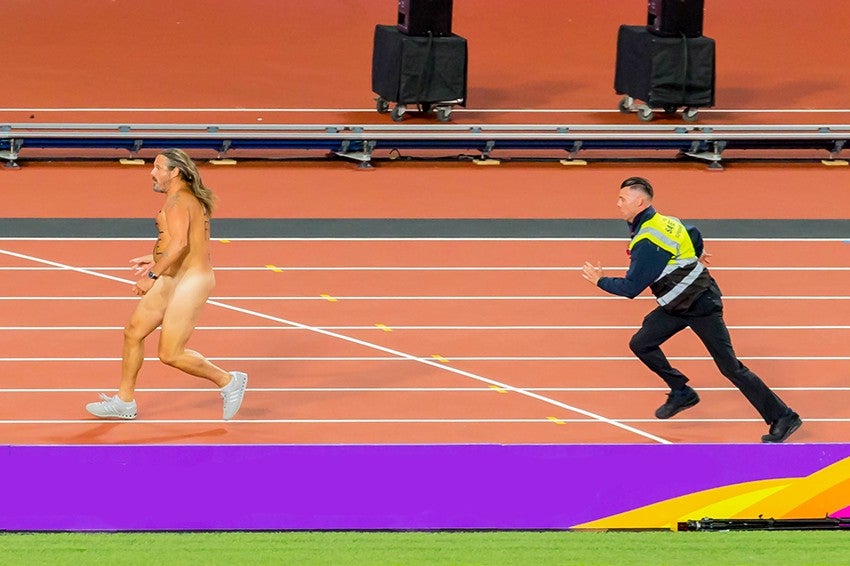Photography via Marco Verch, Creative Commons 2.0
“He is a free spirit, with no bad intentions,” said Kari Snyder Parker when she learned that her 29-year-old son Tristan Lambright, aka “Señor Wiener,” had run across the field at a Buffalo Bills game on Sunday. Then she found out he’d been naked during the stunt. But that didn’t seem to faze her, either: “He is very easygoing and kindhearted,” she said. “He was basically raised by me and my sister. He’s my tender-hearted boy.”
Lambright may be facing a couple of misdemeanor charges that carry a maximum fine of $1,250 and/or up to 90 days in jail, but he also earned himself quite a few admirers, as well as a line of cheeky T-shirts that will benefit a local charity for the homeless.
In the past 200 years of American streaking—and despite our nation’s puritanical bent—public opinion around the practice has been largely benign, even positive. An apocryphal tale holds that Gen. Robert E. Lee, who spent the last five years of his life as president of Washington College — renamed Washington and Lee University after his death in 1870 — officially sanctioned it as a rite of passage for students. The school had been known for streaking since 1804, when a senior, George William Crump, was arrested and temporarily suspended over a nude sprint. The incident hardly haunted him; he later went on to serve in Congress and as ambassador to Chile.
At a seismic moment for the culture of sex, with predators and consent top of mind, you have to wonder how we came to regard this form of public nudity as harmless fun. It would seem the answer has much to do with intent, which is to say motivation. In 1974, at the height of the fad, the British Medical Journal drew a line between this and criminal behavior: “The offence of indecent exposure, which can incur imprisonment, need not have a sexual intent,” the authors wrote, “but streaking is the antithesis of ‘flashing.’ There is no lingering for that shocked look, no chance to catch the look of dawning interest that the ‘flasher’ so vainly hopes his victim will show.”
The Journal instead saw streaking as an answer to épater la bourgeoisie, the rallying cry of the French Decadent poets who wanted to shock the stuffy middle class. Yet we know from the way that streakers are typically laughed off that there’s nothing all that subversive in their hobby. If anything, it’s a humorous return to our state of nature, and the sport of dodging security on a football field is like a radical simplification of the game we are meant to be watching. It may be a “sort of a conservative act — engaging in 1950s hijinks, as opposed to wanting to change the world,” according to Bill Kirkpatrick, an associate professor at Denison University who has studied the phenomenon.
NFL fans do sound far more incensed about players kneeling during the National Anthem than a random drunk guy baring all as he runs for the end zone. Somehow, though done before a massive audience and totally naked, streaking rejects both political and sexual premises. In fact, contrary to the surprise offense entailed by whipping out your privates to harass a group or individual, we almost expect the streaker, an impromptu and (in)appropriate mascot for the drunken, goofy id of the cheering crowd. The streakers themselves often fail to describe the reasoning behind their spontaneous display. They simply see a great expanse of grass as an invitation, just as George Mallory saw Mount Everest as a challenge: “Because it’s there.”
At its best, streaking prompts us to reflect on the custom of clothing, which we usually take for granted. In college I recall streaking with friends at an outdoor tent party, to roars of approval, only to discover that while we were making our circuit, other partygoers had thrown our pants and underwear into the nearby pitch-dark woods. As our search became desperate, it turned hilarious — hadn’t everyone at the event already seen everything? Another time, a small social group was interrupted by streakers who dashed around a common room and then off to a different part of the dorm (we called this “nudie-bombing”). When we regrouped an hour later for a nude counterattack, we found the original streakers all still naked and quietly playing cards. Again, you couldn’t do anything but laugh at the absurdity of the scene. We sat down and said to deal us in.
Even while drawing attention, then, streaking robs nudity of its power to menace or intimidate. The streaker, chased and tackled by authority figures who pay no mind to genital comfort or modesty during the extraction process, is the vulnerable person rather than the predator, sacrificing their body to the spirit of the day. And while indecent exposure itself can potentially land you on a sex offender registry, state laws defining it tend to rely on the element of sexual gratification, notably absent in the streaker’s M.O. A streaker appears to delight the same elemental pleasures of zipping about bare-assed that a carefree toddler enjoys at the beach. If there’s an aspect of exhibitionism to the adult version, it rests in showing up a taboo as largely baseless.
Naked streaker on the field had more rushing yards than the Bills
— Buffalo Ben (@Ben_Freedman) November 12, 2017
But perhaps this over-intellectualizes a behavior that often occurs as though by the flip of a switch, with minimal forethought — and this may be exactly why we permit it, up to a point, as a congenial prank. “It seemed to be a good idea at the time,” Allana Kereopa famously told an Australian court after she and David Cook streaked the race course at the 1974 Doncaster Handicap. Until we tire of shamelessness for its own sake, or the thrill of amusing an entire stadium gets stale, that same bright idea will remain with us: We’re going streaking.

